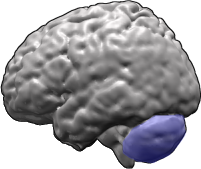A 20-year-old man was discharged from the U.S. Army because of increasing gait abnormalities. One year later, he developed episodes of syncope secondary to high-degree atrial/ventricular block with periods of complete heart block and ventricular asystole. A permanent dual-chamber, rate-responsive cardiac pacemaker was implanted. At age 29 years, an abnormal expansion of the CAG trinucleotide repeat in the ataxin-2 gene on chromosome 12 was identified. This case suggests that cardiac conduction abnormalities should be included as part of the recognized clinical heterogeneity of spinocerebellar ataxia type 2.
Introduction
Spinocerebellar ataxia type 2 (SCA2) is one of several polyglutamine expansion neurodegenerative disorders and is caused by an expansion of an unstable CAG trinucleotide repeat located in the ataxin-2 gene on chromosome 12.1 Cardiac conduction abnormalities have not been previously associated with SCA2.
Case Report
A 22-year-old man was referred for evaluation of "olivopontocerebellar degeneration." There was no family history of neurologic disease. His early development was described as normal. The patient did very well academically in school until age 12 years, when his grades began to decrease and his handwriting became sloppy. Despite some clumsiness, he entered the U.S. Army after graduating from high school. Because of increasing gait problems, he was evaluated at Tripler Army Medical Center at age 20 years. Computed tomography and magnetic resonance imaging scans demonstrated cerebellar and brainstem atrophy. He was also found to be hypothyroid and was started on treatment with levothyroxine. At age 21 years, he began to experience recurrent episodes of syncope that were found to be secondary to high-degree atrial/ventricular block with periods of complete heart block and ventricular asystole. Echocardiography demonstrated normal valves and left ventricular function. A permanent dualchamber, rate-responsive cardiac pacemaker was implanted.
On examination, the patient had scanning speech, slow saccades of eye movements, inability to tandem walk, moderate dysmetria, and absent muscle stretch reflexes. His neurologic examination was otherwise unremarkable.
Over the next several years, his ataxia increased to the point that he became wheelchair dependent for mobility. At age 29 years, an abnormal expansion of the CAG trinucleotide repeat in the ataxin-2 gene on chromosome 12 was identified (44 repeats on allele 1 and 22 repeats on allele 2; normal is less than 31 repeats [Athena Diagnostics, Worcester, Massachusetts]). A diagnosis of spinocerebellar ataxia type 2 was established.
Discussion
Although the clinical heterogeneity of SCA2 is well recognized,2-5 associated cardiac conduction abnormalities have not been described. The frequent association of cardiomyopathy and/or cardiac conduction abnormalities in other neurodegenerative diseases caused by abnormal expansion of trinucleotide repeats (such as myotonic dystrophy6 and Friedreich's ataxia7) and the observation that the ataxin-2 protein is present in human heart8 suggests that cardiac conduction abnormalities in SCA2 are also representative of the clinical heterogeneity of SCA2 rather than just a coincidental observation.
References
1. Imbert G. Saudou F, Yvert G, et al: Cloning of the gene for spinocerebellar ataxia 2 reveals a locus with high sensitivity to expanded CAG/glutamine repeats. Nat Genet 1996; 14: 285-6.
2. Fila A, De Michele G, Banfi S, et al: Has spinocerebellar ataxia type 2 a distinct phenotype? Genetic and clinical study of an Italian family. Neurology 1995; 45: 796.
3. Geschwind DH, Perlman S, Figueroa CP, Treiman LJ, Pulst SM: The prevalence and wide clinical spectrum of the spinocerebellar ataxia type 2 trinucleotide repeat in patients with autosomal dominant cerebellar ataxia. Am J Hum Genet 1997; 60: 842-50.
4. Fernandez M, McClain ME, Martinez RA, et al: Late-onset SCA2: 33 repeats are sufficient to cause disease. Neurology 2000: 55: 569-72.
5. Gwinn-Hardy K, Chen JY, Liu H-C, et at: Spinocerebellar ataxia type 2 with parkinsonism in ethnic Chinese. Neurology 2000; 55: 800-5.
6. Clarke NR, Kelion AD, Nixon J, Hilton-Jones D, Forfar JC: Does cytosine-thymine-guanine (CTG) expansion size predict cardiac events and electrocardiographic progression in myotonic dystrophy? Heart 2001: 86: 411-6.
7. Bit-Avragim N, Perrot A, Schols L, et al: The GAA repeat expansion in intron 1 of the frataxin gene is related to the severity of cardiac manifestation in patients with Friedreich's ataxia. J Mol Med 2001: 78: 626-32.
8. Affaitati A, de Cristofaro T, Feliciello A, Varrone S: Identification of alternative splicing of spinocerebellar ataxia type 2 gene. Gene 2001; 267: 89-93.
Guarantor: CAPT Jack E. Riggs, MC USNR
Contributor: CAPT Jack E. Riggs, MC USNR
Departments of Neurology, Medicine, and Community Medicine, West Virginia University School of Medicine, Morgantown, WV 26506-9180.
The opinions and assertions contained herein are those of the author and do not necessarily reflect those of the Navy Medical Department or the Department of Defense.
This manuscript was received for review in October 2001 and was accepted for publication in March 2002.
Copyright Association of Military Surgeons of the United States Sep 2002
Provided by ProQuest Information and Learning Company. All rights Reserved



